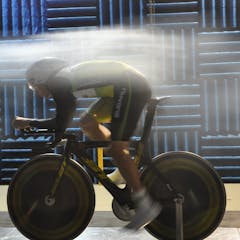
Articles on Biomechanics
Displaying 41 - 60 of 62 articles

It is never easy to run 100m in less than ten seconds, as the recent Commonwealth Games demonstrated. However, as the world record stands at 9.58 seconds, the attention in recent years has turned to whether…

The Commonwealth Games women’s javelin finals were held overnight, with Aussies Kim Mickle and Kelsey-Lee Roberts picking up gold (plus a Games record) and bronze respectively. Seven-time British champion…

As the Tour de France approaches its final days, teams will be looking to place their top riders in the best possible position for the all-important individual time trial in the penultimate stage, where…

The swimming events of the Glasgow Commonwealth Games are among the first on the schedule. Australia and the UK tend to do quite well in the swimming events – as does Canada – so it’s an excellent opportunity…

A big serve proved its value as part of Australian wild card Nick Kyrgios’ game yesterday, with 37 aces in his fourth round Wimbledon victory over world number one Rafael Nadal. Kyrgios, the first player…

When people think about biomechanics in health it’s more than likely they will think of treatments related to the human musculoskeletal system, such as treating knee injuries or osteoarthritis. But this…

Even though a blue whale is much heavier than a tuna, the mammal consumes less energy per unit weight than the fish when they travel the same distance. For years, these sort of comparisons have dominated…

There’s so much information out there on how to run, but here’s the best way to do it long distance.

Across the globe, hundreds of species of birds can be seen flying in V-formations. We have long suspected that these formation might help birds fly with less effort. Yet the precise mechanics have remained…

Teaching a robot to walk – even poorly – requires huge investment into computational resources. How is it that even the simplest animals are able to achieve far more sophisticated feats of manoeuvrability…

Another Ashes cricket series is upon us and, once again, all the talk is about who has the most potent bowling attack. But, of course, injuries can thwart the best laid plans – so how can biomechanics…

Researchers have used gadget-laden collars to record cheetahs’ movements in the wild. They found that cheetahs succeed not because it is the fastest animal on land, but because of its incredible acceleration…

You must have heard that spider silk is stronger than steel. We all want to believe that there are wonder materials in nature that are far superior to human-made ones. But the problem with statements that…

Every January the Australian Open attracts the world’s best tennis players to Melbourne in a bid to become champion of the Asia-Pacific Grand Slam. While the players are undoubtedly the main draw card…

We once thought no-one could run a mile in less than four minutes – and yet the current world record stands at three minutes, 43 seconds. So will records keep tumbling as people get fitter and technology…
Larger animals with longer legs aren’t always the fastest when sprinting, but then neither are smaller animals. Researchers…

Today in Melbourne the 2012 UCI Track Cycling World Championships get underway. Results from the five-day competition will determine which riders represent the various national track cycling teams at the…

Australia’s summer of tennis is a great opportunity to see the world’s best players up close, hitting hard and serving big. Many elite players hit first serves at over 200km/h with great precision and…

A new wearable device that predicts which people are more at risk of falls could help prolong the number of years elderly people can spend living independently at home. A third of over-65s take a tumble…

This weekend, approximately 200 of the world’s best cyclists will begin competing in one of the most challenging sporting events in the world: Le Tour de France. Le Tour is widely regarded as the most…
